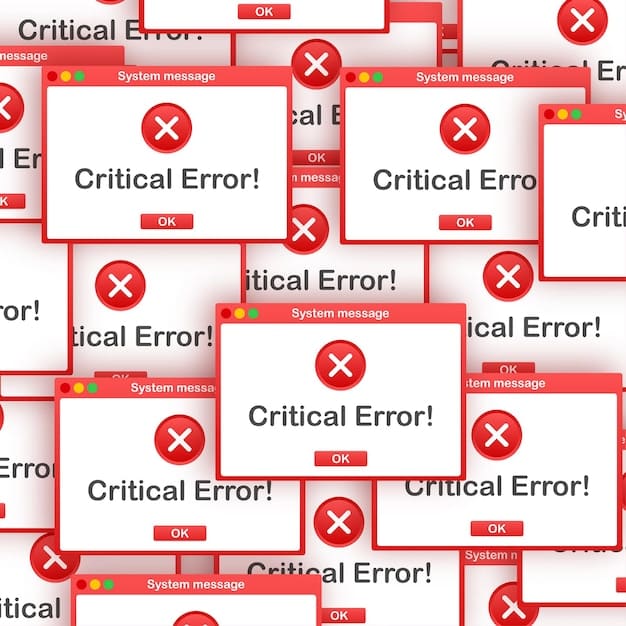Assessing Misinformation Strategies in Social Commentary: A 6-Month Review

How Effective are Current Strategies for Combating Misinformation in Social Commentary? A 6-Month Assessment reveals that a multi-faceted approach combining media literacy, platform accountability, and fact-checking initiatives shows promise but faces challenges due to evolving tactics and partisan polarization.
The proliferation of misinformation in social commentary poses a significant threat to informed public discourse. A critical question arises: How Effective are Current Strategies for Combating Misinformation in Social Commentary? A 6-Month Assessment can provide valuable insights into the successes and shortcomings of various intervention methods.
Understanding the Landscape of Misinformation
The rise of social media has amplified the spread of misinformation, making it crucial to understand its various forms and motivations. This section delves into the current misinformation environment, exploring the key players and the tactics they employ.
Misinformation now easily permeates digital channels, affecting opinion and public perspectives. Strategies to counter it must be adaptable and comprehensive.
Types of Misinformation
Misinformation isn’t a monolith. It appears in various forms, each requiring a distinct counter-strategy.
- Disinformation: Deliberately false or misleading information spread to deceive.
- Misinformation: False or inaccurate information spread unintentionally.
- Malinformation: Information based on reality but used to inflict harm, such as doxxing or revealing private information.
Motivations Behind Misinformation
Understanding the reasons behind misinformation campaigns helps in devising appropriate responses.
Motivations can range from financial gain through advertising revenue to political manipulation aimed at influencing elections or social unrest.

Combating misinformation requires a deep understanding of its origins. This includes identifying the sources that create and disseminate false information, as well as the individuals who share it, unwittingly or otherwise.
In conclusion, the proliferation of misinformation demands a multi-faceted approach. By understanding the types of misinformation and the motivations behind it, it is easier to create strategies to tackle the challenge effectively.
Fact-Checking Initiatives: An Assessment
Fact-checking organizations have become central in the battle against misinformation. This section evaluates their role, methodologies, and overall impact, focusing on developments over the past six months.
Fact-checking brings credible sources to discussions marred by false narratives. With their intervention, the public benefits from clarified truth and rebuttals of falsehoods.
Methodologies and Challenges
Fact-checkers use diverse strategies to verify claims. However, they face their own set of challenges.
These include the speed at which misinformation spreads, the difficulty of debunking deeply entrenched beliefs, and the political polarization that can undermine their credibility.
- Verification of Claims: Rigorous examination of statements against credible sources.
- Independent Analysis: Objective assessment of claims, free from bias.
- Partnerships with Media: Collaborations to amplify fact-checked content.
Effectiveness Metrics
Measuring the true effectiveness of fact-checking is complicated. However, some key indicators exist.
Metrics often include the reach and engagement of fact-checked content, the impact on public perception, and the degree to which platforms incorporate fact-checking into their policies.
Fact-checking effectiveness is also reflected in the reduced sharing of debunked content on social media. If disinformation is identified and flagged swiftly, fewer casual users become exposed to its effects.
To conclude, while fact-checking is useful in slowing misinformation’s advance, it’s not a cure-all. Continual advancement and adjustment of its approaches makes it suitable to social commentary.
Platform Accountability and Content Moderation
Social media platforms are under increasing pressure to address the spread of misinformation on their services. This section assesses the effectiveness of content moderation policies and algorithmic interventions implemented by these platforms in the last six months.
The policies of social platforms are continually being refined to mitigate false information and reduce its effects among users.
Content Moderation Policies
Social media platforms have released a host of content moderation policies aiming to stop misinformation, but their application varies considerably.
These policies range from labeling false content to removing accounts that repeatedly spread disinformation.

Effectiveness is often tied to the scale policies are implemented. It’s also important to consider how readily these policies adapt to the constantly changing types of disinformation being spread.
Algorithmic Interventions
Some platforms use algorithms to demote or remove misinformation. But, algorithms aren’t perfect.
- Demotion of False Content: Reducing the visibility of posts flagged as misinformation.
- Recommendation Algorithms: Adjusting algorithms to prevent the recommendation of unreliable sources.
- AI Detection Tools: Employing AI to detect and flag potential misinformation.
Many platforms are still working to fine-tune the precision of their algorithms. Accuracy is a must to prevent the censorship of legitimate content.
The actions of social media platforms are crucial for dealing with misinformation. A combination of content moderation and smart algorithms can make a big difference. But maintaining transparency and objectivity is essential to win public trust.
Media Literacy Education Programs
Education is key in fighting misinformation in the long term. This section explores and measures how effective different programs are in teaching the public to recognize and resist misleading info, based on recent trials.
By empowering individuals with the necessary critical thinking skills, these programs aspire to create a more informed and discerning public.
Curriculum Design and Implementation
Media literacy programs come in different shapes and forms. Some are integrated into school curriculums as a core subject, while others are offered as workshops or online courses.
What works best often depends on the specific audience and the resources available.
An important part is teaching essential skills in the identification of deep fakes and bot-driven content.
Assessing Program Effectiveness
Evaluating the effectiveness of media literacy programs can be challenging. It requires measuring changes in attitudes, knowledge, and behavior related to media consumption.
Surveys, quizzes, and behavioral experiments can all provide insights.
Media programs that effectively prepare the public for an influx of disinformation may show fewer misleading stories or posts being shared by those who have participated.
In summary, media literacy education is a critical tool in the fight against misinformation. Though it’ll take time to see big changes, it brings hope for raising a more media-savvy upcoming generation.
The Role of Government and Regulation
Government involvement in regulating misinformation is a contentious issue. This section analyzes existing and proposed regulations, focusing on their impact on free speech and the spread of false information.
Finding the right balance between safeguarding freedom of speech and protecting the public from misinformation is a complex challenge. Regulation must be approached carefully to avoid unintended outcomes.
Existing Regulations and Laws
Many countries have regulations on the books that address aspects of misinformation, such as defamation laws and false advertising regulations.
But often none of these are precise or wide enough to deal with today’s disinformation landscape.
- Defamation Laws: Protecting individuals from false statements that harm their reputation.
- False Advertising Regulations: Preventing companies from making misleading claims about their products or services.
- Election Laws: Prohibiting the spread of false information intended to influence voters.
Proposed Regulatory Frameworks
Different regulatory models are being discussed. Their goal is to address today’s misinformation challenges.
These include mandating transparency for online platforms to creating agencies dedicated to monitoring and combating misinformation.
The government is central to keeping our conversations real and information true. Yet, any new regulation needs careful consideration of freedom of expression.
To conclude, the role of government in the fight against misinformation balances intervention and protection of fundamental freedoms. The specifics require careful management to prevent negative side effects.
Community-Based Initiatives and Grassroots Efforts
While top-down solutions are important, community-based initiatives and grassroots efforts can also play a crucial role in combating misinformation. This section examines such initiatives, looking at how they use trusted local networks to address misinformation.
These initiatives often focus on building trust and fostering critical thinking skills within specific communities.
Local Fact-Checking and Verification
Local fact-checking initiatives focus on verifying information specific to their communities.
This can be particularly effective in addressing misinformation related to local events, politics, or public health issues.
Successful initiatives empower members with knowledge, strengthening individual resilience against manipulation.
Community-Led Media Literacy Workshops
Community-led media literacy workshops educate community members on how to critically analyze information and identify misinformation.
Such workshops often leverage trusted community leaders and organizations to deliver their message.
Effective programs show the importance of thinking through what we read, helping to stop the spread of digital inaccuracies.
To summarize, community focused tactics in managing misinformation creates trusting environments where fact-checking and media smarts can flourish.
| Key Point | Brief Description |
|---|---|
| 🔍 Fact-Checking | Organizations verify claims and debunk false information. |
| 📱 Platform Accountability | Social media platforms moderate content and use algorithms to reduce misinformation. |
| 📚 Media Literacy | Education programs teach critical thinking and media analysis skills. |
| 🏛️ Government Regulation | Regulations and laws aim to balance free speech and protection from false information. |
Frequently Asked Questions
▼
The main strategies include fact-checking initiatives, content moderation by social media platforms, media literacy education, and governmental regulations aimed at curbing the spread of false information.
▼
Fact-checking organizations play a crucial role by verifying claims and debunking false information. They work to inform the public, although their reach can be limited by the speed of misinformation spread.
▼
Social media platforms are increasingly under pressure to moderate content, label misinformation, and adjust algorithms to reduce the spread of false or misleading information among their users.
▼
Media literacy education equips individuals with the critical thinking skills needed to evaluate information, recognize biases, and identify misinformation, helping them become more discerning consumers of media.
▼
Regulating misinformation requires careful consideration of freedom of speech. Regulations must be narrowly tailored to address specific harms, and should not unduly restrict legitimate expression or create censorship.
Conclusion
In summary, the battle against misinformation in social commentary requires a multi-faceted approach that combines technological interventions, educational initiatives, and regulatory frameworks. By persistently pursuing a balance of innovation, education, and sound policy, society can strive toward a more informed and reliable public discourse.





